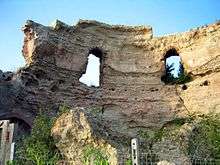Avernus

Avernus was an ancient name for a volcanic crater near Cumae (Cuma), Italy, in the Region of Campania west of Naples. Part of the Phlegraean Fields of volcanoes,[1] Avernus is approximately 3.2 kilometres (2.0 mi) in circumference. Within the crater is Lake Avernus (Lago d'Averno).
Role in ancient Roman society
Avernus was believed to be the entrance to the underworld, and is portrayed as such in the Aeneid of Virgil. The name comes from the Greek word aornos (ἄορνος < a- ‘no’ + ornis ‘bird’),[2] meaning "without birds", because according to tradition, all birds flying over the lake were destined to fall dead. This was likely due to the toxic fumes that mouths of the crater gave off into the atmosphere. In later times, the word was simply an alternate name for the underworld.
On the shores of the lake is the grotto of the Cumaean Sybil and the entrance to a long tunnel (Grotta di Cocceio, ca. 800 metres (2,600 ft)) leading toward Cumae, where her sanctuary was located. There are also the remains of temples to Apollo and Jupiter. During the civil war between Octavian and Antony, Agrippa tried to turn the lake into a military port, the Portus Julius. A waterway was dug from Lake Lucrino to Avernus to this end. The port's remains may still be seen under the lake's surface.
Averni
The term avernus (plural averni) was also used by ancient naturalists for certain lakes, grottos, and other places which infect the air with poisonous steams or vapours. They were said to be frequent in Hungary on account of the abundance of mines there. The Grotto dei Cani in Italy was a famous example.[3] The most celebrated of these, however, is Lake Avernus.
They were also called mephites. Mephitis was the Roman goddess of noxious vapors, who protects against malaria. The adjective "mephitic" means "foul-smelling" or "malodorous".
See also
- Ploutonion, "grotto of Plouton," a Greek term for a mephitic sanctuary
References
- ^
 Chisholm, Hugh, ed. (1911). "Avernus". Encyclopædia Britannica (11th ed.). Cambridge University Press.
Chisholm, Hugh, ed. (1911). "Avernus". Encyclopædia Britannica (11th ed.). Cambridge University Press. - ^
 This article incorporates text from a publication now in the public domain: Chambers, Ephraim, ed. (1728). "article name needed". Cyclopædia, or an Universal Dictionary of Arts and Sciences (first ed.). James and John Knapton, et al.
This article incorporates text from a publication now in the public domain: Chambers, Ephraim, ed. (1728). "article name needed". Cyclopædia, or an Universal Dictionary of Arts and Sciences (first ed.). James and John Knapton, et al.
- ↑ Siebert, Lee; Simkin, Tom; Kimberly, Paul (2011). Volcanoes of the World (3rd ed.). University of Calif. Press. p. 50. ISBN 978-0-520-94793-1.
[in the chart] Campi Flegrei [...] Averno
- ↑ "Avern". Oxford English Dictionary (3rd ed.). Oxford University Press. September 2005. (Subscription or UK public library membership required.) "L. Avernus (sc. lacus), = Gr. ἄορνος (λίµνη) the birdless (lake), f. ἀ priv. + ὄρνις bird."
- ↑ Curtis, Thomas (1829). The London Encyclopaedia. 3. T. Tegg. p. 269.
External links
- Cyclopædia (1728) article “Averni”.
- Lake Avernus with the Temple of Apollo and a Distant View of Cape Misenum (1819), a very faint pencil sketch by Joseph Turner (see also: Cape Misenum)
